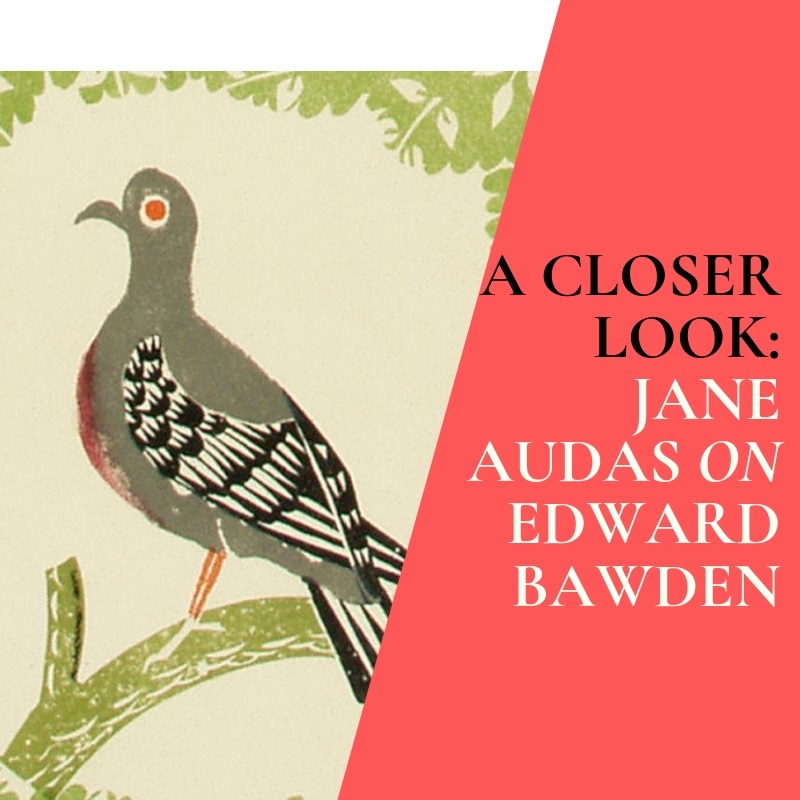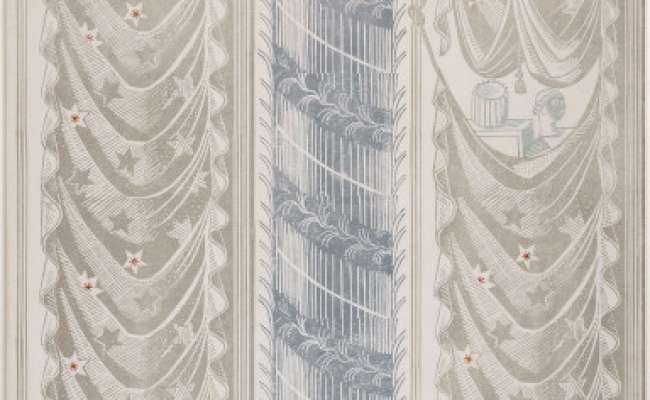
There are now many books on Bawden, examining his output in detail. Yet his wallpapers have only recently been part of that publishing story. And they have recently been reproduced, ready to decorate the interiors of a whole new generation of admirers.
Bawden, Eric Ravilious and Peggy Angus were at the RCA together in the 1920s, with Bawden training as an illustrator and calligrapher. The group were admiring of English folk – or traditional – arts, particularly from the nineteenth century. From Staffordshire Pottery and lusterware to wooden shop signs, ship figureheads and naive art. Their love of highly decorated forms, combined with the ease with which they moved between the fine and decorative arts in their own practices, led Bawden and Angus to experiment with wallpaper design. Bawden’s wallpaper’s were the most artistically formed but Angus was a more determined saleswoman.
Bawden’s wallpaper designs
Bawden made his first wallpaper in 1924, inspired to try lino-cutting by a friend, and a glimpse of artist Claude Flight’s linocuts at the V&A. Bawden’s wallpapers were lithographically reproduced by the Curwen Press between 1927 and 1933. Curwen were printers of all things graphic and beautiful at that time. Bawden was already designing patterned papers for them and the wallpaper sheets that Curwen produced were small for wallpaper, as they were printed on the same press.
Most of Bawden’s early wallpaper designs were pictorial, very much extensions of his illustration work. They were also whimsical, from the first wallpapers featuring cows, fish, conservatories, pigeons and scenes of park life. Bawden cut his designs in lino, which was transferred by Curwen to a lithographic plate. The wallpapers sold in Elspeth Little’s shop called Modern Textiles.
The ‘Plaistow’ wallpapers
In 1932 Curwen commissioned 4 ‘Plaistow’ wallpaper designs, sold as 13 sheet ‘pieces’. The Plaistow wallpapers were the bridge between these earlier figurative designs and his later wallpapers which were more traditional trellis-based wallpapers, quite Regency in feel, decorative but more conservative and arguably more commercial.
The ‘Bardfield’ Wallpaper series
The Bardfield Wallpaper series designed by Bawden with John Aldridge (a neighbour, fellow artist and wallpaper designer) was exhibited at Muriel Rose’s Little Gallery in the late 1930s. The Second World War put a stop to wallpaper production but the Bardfield series was taken up by Cole & Sons after the war. They were put into production in 1946, despite the continuation of paper rationing. This was Bawden’s first wallpaper printed by the roll, rather than small pieces to be assembled.
Bawden’s last wallpaper was designed in 1956 for a Sanderson’s exhibition called Decorama 56. Staff of the RCA had been invited to design the furnishings of Flat 56, and Bawden contributed a wallpaper.
Three of Bawden’s early wallpaper designs have recently been reprinted by St Jude’s Fabrics and Wallpapers. Their appeal is undiminished and they still look as pleasing and eccentric on walls as they did in the late 1920s, when Bawden first cut into that lino.
Jane Audas is a freelance digital producer, writer and curator.






















